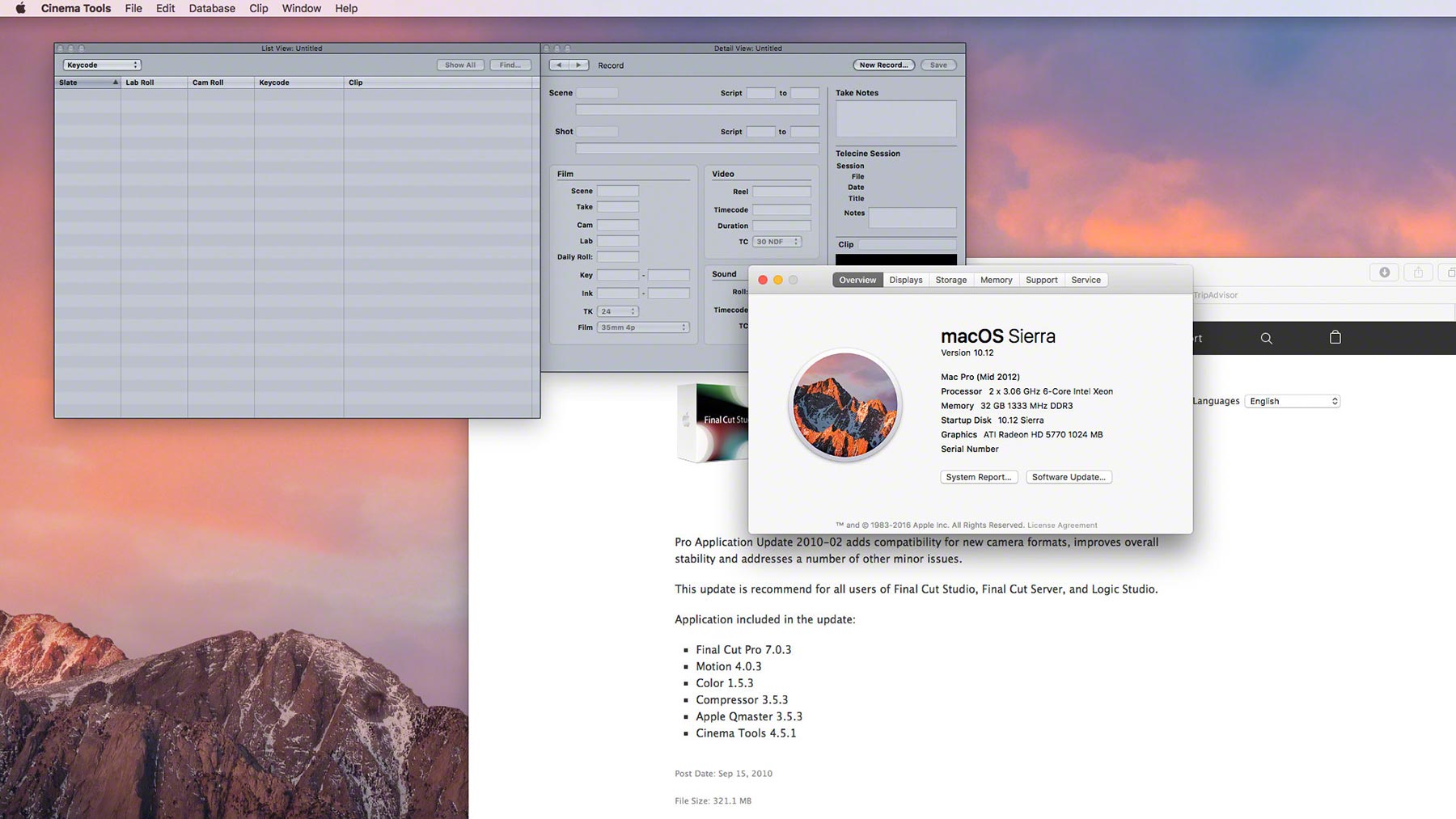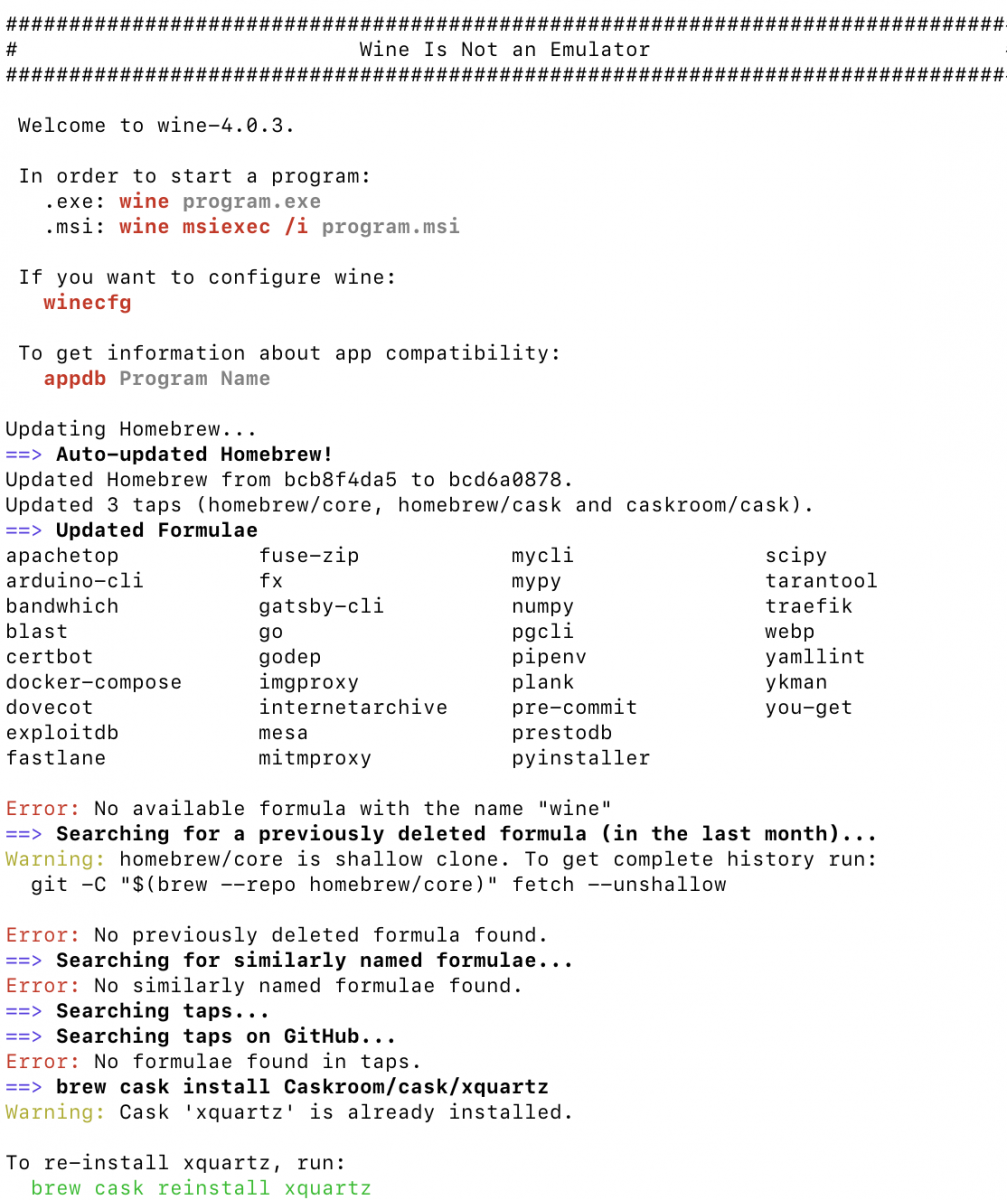Malept changed the title electron-packager.all to make Windows app on Mac Cannot find wine despite wine-stable installed via homebrew Feb 24, 2020 malept changed the title Cannot find wine despite wine-stable installed via homebrew Cannot find wine64 despite wine-stable installed via homebrew Feb 24, 2020.
- How To Install Homebrew On Mac
- Install Wine On Mac With Homebrew
- Install Wine On Mac Brew
- Wine For Mac
- Mac Homebrew
Instructions for a supported install of Homebrew are on the homepage.
- I'm trying to install Wine on my Mac via Brew. I'm using Catalina and just updated brew, installed XQuartz and have Xcode installed. When I type the command 'Brew install wine' it returns the following: Error: No available formula with the name 'wine' Searching for a previously deleted formula (in the last month).
- If a formula fails to build, uninstall MacPorts/Fink and try again. Installing wine dependency: libicns Downloading Already downloaded: /Library/Caches/Homebrew/libicns-0.8.1.tar.gz./configure -prefix=/usr/local/Cellar/libicns/0.8.1 make install WritePNGImage in icns2png.o ld: symbol(s) not found for architecture i386 clang: error.
- Part 1: Install Homebrew. Homebrew is a package manager that makes installing open source programs much easier. In particular, trying to install a large program like Wine without the help of a package manager would be tremendously difficult. Fortunately, Homebrew itself is simple to install: just open up the Terminal and run this command.
This script installs Homebrew to its preferred prefix (/usr/localfor macOS Intel, /opt/homebrew for Apple Silicon) so thatyou don’t need sudo when youbrew install. It is a careful script; it can be run even if you have stuffinstalled in /usr/local already. It tells you exactly what it will do beforeit does it too. You have to confirm everything it will do before it starts.
macOS Requirements
How To Install Homebrew On Mac
- A 64-bit Intel CPU or Apple Silicon CPU 1
- macOS Mojave (10.14) (or higher) 2
- Command Line Tools (CLT) for Xcode:
xcode-select --install,developer.apple.com/downloads orXcode3 - A Bourne-compatible shell for installation (e.g.
bashorzsh) 4
Git Remote Mirroring
You can set HOMEBREW_BREW_GIT_REMOTE and/or HOMEBREW_CORE_GIT_REMOTE in your shell environment to use geolocalized Git mirrors to speed up Homebrew’s installation with this script and, after installation, brew update.
/004_skype-for-mac-download-and-installation-1949505-5bb271d6cff47e00265bbd8f.jpg)
The default Git remote will be used if the corresponding environment variable is unset.
Alternative Installs
Linux or Windows 10 Subsystem for Linux
Check out the Homebrew on Linux installation documentation.
Untar anywhere
Just extract (or git clone) Homebrew wherever you want. Just avoid:
- Directories with names that contain spaces. Homebrew itself can handle spaces, but many build scripts cannot.
/tmpsubdirectories because Homebrew gets upset./swand/opt/localbecause build scripts get confused when Homebrew is there instead of Fink or MacPorts, respectively.
However do yourself a favour and install to /usr/local on macOS Intel, /opt/homebrew on macOS ARM,and /home/linuxbrew/.linuxbrew on Linux. Some things maynot build when installed elsewhere. One of the reasons Homebrew justworks relative to the competition is because we recommend installinghere. Pick another prefix at your peril!
Multiple installations
Create a Homebrew installation wherever you extract the tarball. Whichever brew command is called is where the packages will be installed. You can use this as you see fit, e.g. a system set of libs in /usr/local and tweaked formulae for development in ~/homebrew.
Uninstallation
Uninstallation is documented in the FAQ.
1 For 32-bit or PPC support seeTigerbrew.
2 10.14 or higher is recommended. 10.9–10.13 aresupported on a best-effort basis. For 10.4-10.6 seeTigerbrew.
3 Most formulae require a compiler. A handfulrequire a full Xcode installation. You can install Xcode, the CLT, or both;Homebrew supports all three configurations. Downloading Xcode may require anApple Developer account on older versions of Mac OS X. Sign up for freehere.
4 The one-liner installation method found onbrew.sh requires a Bourne-compatible shell (e.g. bash orzsh). Notably, fish, tcsh and csh will not work.
A NOTE ABOUT MAC OS 10.15 CATALINA:
Apple has decided to force 64 bit operation and is blocking unsigned software in Catalina – so Wine is much more challenging in that version. Hams are recommended to stay with Mojave for this reason. See here if you are ready for the extra work to make Catalina Wine-friendly again.
NEW: As of Wine version 4.19 or newer, Forms and Templates, such as the ICS-213) are now working! This means Winlink Express (RMS Express) is fully functional!
Wine is a program that tricks Windows applications into thinking they are running in a full-blown Windows OS environment. It only loads bare-bones drivers and a Windows-like folder structure into a “Bottle”, so this is NOT a Windows emulator. It runs Windows apps directly in Mac OSX or Linux!
STEP 1: INSTALL HOMEBREW
Run in Terminal app:ruby -e '$(curl -fsSL https://raw.githubusercontent.com/Homebrew/install/master/install)' < /dev/null 2> /dev/null
and press enter/return key.
If the screen prompts you to enter a password, please enter your Mac’s user password to continue. When you type the password, it won’t be displayed on screen, but the system would accept it. So just type your password and press ENTER/RETURN key. Then wait for the command to finish.
STEP 2: INSTALL WINE
Run this command in Terminal:export WINEARCH=win32
then run this command:brew install wine-stable
STEP 3: Install Winetricks
- Press
Command+Spaceand type Terminal and press enter/return key. - Run this command in Terminal:
brew install winetricks - Run this to add a GUI for Winetricks
STEP 3: Load DotNET 3.5sp1 and Visual Basic into the Bottle
Open a window in Terminal and enter the command:
winetricks

A new window will appear (if it’s blank, click OK). A window with a long list of optional Windows components and common software that can be added to a Bottle. Click on “Install a Windows DLL or component” and then click OK. Scroll down and check the boxes next to “dotnet35sp1″ and ‘vb6run” then click on the “Apply” button at the bottom of the window.
After a download completes, a number of Windows installer screens will appear… always click yes or I agree, etc., to install the software. If it asks for your name, just enter any first name and click OK. When all installations are complete, you will get a message that says “Winetricks Applied Successfully”.
NOTE: If you got an error message, you will need to run Winetricks again and select “Create a new wineprefix”. In the window that pops up, select Architecture: 32 and name the prefix “Ham” or something like that. Then repeat Step 3 again.

STEP 4: INSTALL RMS EXPRESS (and any other Windows software you like)
Download the latest version of Winlink Express (formerly RMS Express) here. Just look for the latest version of Winlink Express and click on it.
Once it downloads, unzip it and do a “Get Info” on the .exe file by Control-Click on the icon (or highlighting the icon and selecting “Get Info” in the File pull-down menu). Change the “Open with:” pull-down to “Wine” and click on the “Change All…” button so all exe files will launch under Wine. Close the Get Info window.
Now double-click the Winlink Express Installer and if all went well the program will function! There are extra steps (below) for COM Port setup if you want rig control or access to a TNC and there are also more components needed if you plan to use VARA on HF. See below.
OPTIONAL STEP A: COM PORT SETUP
IMPORTANT: First try using COM33 for USB Serial cables for TNCs, etc. IF that doesn’t work, then try this option below:
If COM33 doesn’t work, we can create COM1 port for rig control or TNC access. SKIP THE REST OF THIS STEP IF COM33 ALREADY WORKS!
First we need to find out what our USB/Serial controller cable is named. Install the driver for your cable. Plug the cable in and bring up a terminal (Terminal app can be found in Applications/Utilities).
ls /dev
This command lists the contents of the “dev” directory. Scroll up and look for the name of the USB cable. Some common names are:
tty.SLAB_USBtoUART
tty.usbeserial
tty.ftdi_usbserial
cu.usbserial
It WILL start with either tty or cu …so if you can’t find them in the long list, try the command:
ls /dev/cu* or ls /dev/tty*

Highlight the name and copy it (we will paste it in the next step)
This command will make a symlink (aka, an alias or shortcut) for COM1 in the dosdevices folder, which points to the USB device – usually ttyUSB0 on linux, for Mac see below:
Copy the name and paste below and use your user login name and bottle name in the bolded text (replacing the brackets):
ln -s /dev/[pasted name] ~/.wine/dosdevices/com1
Just to be clear, the entire bold part of the line above including the brackets will become the name you copied, and there will be a space between the last letter of the name you paste and “~/.wine/dosdevices/com1” Once you hit the ENTER or RETURN key, that should link the device to the new virtual COM port.
Install Wine On Mac With Homebrew
Now add the COM port to the windows registry (this will make it appear in pull-down menus in RMS Express and other Windows programs running in that bottle).
sudo nano ~/.wine/system.reg
After “#arch-win32”, add the following lines (using the arrows keys to place the cursor where you want to copy/paste this) , save and exit.
Install Wine On Mac Brew
[HardwareDevicemapSerialcomm] 1131331688
“COM1″=”COM1”
NOTE: If you need more than one COM port for different control cables, just repeat the process with COM2, COM3, etc.
To save these changes, hit the CONTROL and X keys, then tap Y and then tap ENTER.
If all went well, your COM port will work now! Please note that some recent changes to the Wine software MAY force your USB-serial device onto COM33 …so if the above steps didn’t work, look for COM33 in the COM Ports pull-down of your software and try that.
OPTIONAL STEP B: GETTING VARA MODE TO WORK IN WINLINK EXPRESS
For VARA support, download these components:
and place them in /Users/[user name]/Documents/Wine/drive_c/windows/system32 and if any exist, replace them. VARA won’t work without these.
Wine For Mac
TROUBLESHOOTING: If you are still having problems installing RMS Express or getting VARA to launch within the program, check to make sure you didn’t skip a step in the DotNET and Visual Basic Runtime installations. You need all those components to be working first. Also be sure you are running Wine in a folder named “Wine” in your Documents folder for any of the above instructions to work. THIS IS CASE-SENSITIVE!

Mac Homebrew
If DotNET won’t install or returns any errors at all, you may be better off using the commercial “Crossover Mac” software ($39) See here